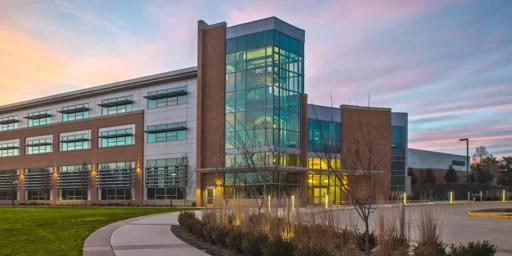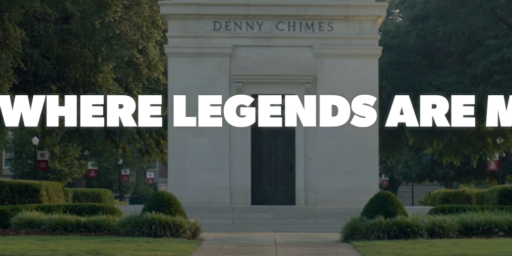Are For-Profit Colleges Worse than Public Colleges?
Private college degree mills have come under intense scrutiny. But many public institutions have similar statistics.
Atop my inbox this morning was an unsolicited email from a PR firm titled “Higher Ed Bubble: Why are feds ignoring college swindles?” The full text:
For several months, the Obama Department of Education and Sen. Tom Harkin (D-IA), among others, have been engaged in a war on for-profit career colleges. Forget for a moment that this aggressive regulatory and legislative assault is hypocritical at a time when the administration is planning to dole out an additional $8 billion taxpayer handout to failing community colleges, many of which have graduation rates and student debt rates comparable to for-profit career schools.
We now discover that many four-year non-profit schools, which benefit tremendously from taxpayer “generosity,” perform worse than the bad apples in either the for-profit or community colleges sectors.
The question is: Where is the big federal report (like the bogus and debunked GAO report against for-profits) calling attention to these schools and others like them? Are the only schools subject to Washington scrutiny those in the private sector?
The GAO report on for-profit universities wasn’t so much “flawed” as unfair. According to the WaPo story linked above and provided as the only proof that the report was “bogus and debunked,” the GAO itself revised the study to “soften” it but was “standing by its central finding that colleges had encouraged fraud and misled potential applicants.” (It’s also worth mentioning that WaPo is a money loser that’s propped up by Kaplan, Inc.—one of the most egregious offenders in the for-profit racket.) The meat of the changes:
The revised report, posted Nov. 30 on the GAO Web site, changed some key passages. In one anecdote cited as an example of deceptive marketing, the GAO originally reported: “Undercover applicant was told that he could earn up to $100 an hour as a massage therapist. While this may be possible, according to the [Bureau of Labor Statistics] 90 percent of all massage therapists in California make less than $34 per hour.”
The revised version states: “While one school representative indicated to the undercover applicant that he could earn up to $30 an hour as a massage therapist, another representative told the applicant that the school’s massage instructors and directors can earn $150-$200 an hour. While this may be possible, according to the BLS, 90 percent of all massage therapists in California make less than $34 per hour.”
In another example, the report originally stated that a college representative “told the undercover applicant that by the time the college would be required by [the] Education [Department] to verify any information about the applicant, the applicant would have already graduated from the 7-month program.”
The revised version states that “the undercover applicant suggested” that possibility and the “representative acknowledged this was true.”
So, it sounds like the investigators conducted a sting operation, did their best to lead the interviewees down a path, and were less than charitable in how they reported the interactions. That’s pretty standard in a police sting but unseemly in what’s supposed to be a neutral truth-finding investigation. That doesn’t really have much bearing, however, on whether for-profit schools are degree mills.
Below the signature block in the aforementioned email, there was also a link to an annoying Fiscal Times listicle titled “11 Public Universities with the Worst Graduation Rates.” Ironically, given its linkage with the “debunked” GAO report, it begins with a factoid that’s so obviously misleading as to render the rest of the article suspect:
Just 56 percent of college students complete four-year degrees within six years, according to a 2011 Harvard Graduate School of Education study. Among the 18 developed countries in the OECD, the U.S. was dead last for the percentage of students who completed college once they started it ― even behind Slovakia.
The reason is patently obvious to anyone who knows anything about international education practices: in the United States, practically anyone can get into college. Our finest universities are the best in the world; we simply dominate the top tier and attract great students from all over the planet. But we also have a plethora of open admissions regional colleges that make it easy for students who either aren’t academically competitive enough to get into or can’t afford to attend a major university to enter college. But these students are often marginal college material, lacking in family support structure, and/or financially unable to sustain going to college full time. Consequently, it’s not shocking that a large percentage of them fail to finish college in six years–or at all.
The Fiscal Times piece later asserts,
[T]here are a number of four-year public universities, funded in part by taxpayer dollars, which have graduation rates that are just as bad ― or worse ― as their for-profit counterparts.
Sure. For reasons already discussed. Let’s look at the list:
1. Southern University at New Orleans, Louisiana: A historically black college. Actually, a branch campus of one, opened in 1956. One that was absolutely devastated by Hurricane Katrina. From the Wikipedia entry: “Not only was there physical damage done to the University, but its academics had also been threatened. Twenty of the University’s programs were stripped due to the loss of students and faculty. Prior to Katrina SUNO’s enrollment exceeded 3,600 students but it was projected that the enrollment would dip to as few as 1,200 students. To the surprise of many, SUNO’s enrollment regained more than 2,000 including online students when the University returned to grounds near the Park Campus in the spring of 2006.” Governor Bobby Jindal led an effort last year to merge SUNO with the University of New Orleans but was defeated.
2. University of the District of Columbia, Washington DC: The only public university in the nation’s capital, it’s been a basket case for years. Also a historically black college.
3. Kent State University-East Liverpool, East Liverpool, Ohio: A tiny branch campus with 902 students, 402 of whom are part-timers. Its student body is virtually all white; it’s also 72% female. Without more information (such as economic background and SAT scores) it’s difficult to figure out why it has a measly 12% graduation rate (although a 62% retention rate). Given the small numbers, it may be a statistical fluke. It’s essentially an open admissions school, though, with an 88.7% acceptance rate.
4. Rogers State University, Claremore, Oklahoma. It’s been around more than a century, although it only started offering bachelor’s degrees in 2000. Previously, it was a prep school, a military academy, and a junior college. It’s quite small, with only 3903 students, 2282 of them full-time. It’s also predominately white and traditional, with only 0.36% over-25 enrollment.
5. Texas Southern University, Houston, Texas is an odd case, in that it’s highly selective by state school standards. It’s also historically black and still has a predominantly black student body.
It’s not worth the time to go through the other six schools on the list in detail but the pattern remains the same: mostly historically black colleges and/or branch campuses serving lower-income communities.
When I wrote to the sender of the email, observing that “schools whose student body is made up primarily of marginal, low-income students tend not to have high graduation rates” is ” like saying undrafted free agents tend not to have good 5-year retention rates on NFL rosters,” he responded,
Community Colleges, some four-year non-profits, and for-profit career schools that tend to serve lower-income and non-traditional student constituencies and therefor have similar statistics in terms of student debt and dropout vs. graduation rates. And yet it is only the for-profit career college sector that has drawn scrutiny from the Dept. of Education and the U.S. Congress. Meanwhile, community colleges were promised $8 billion more in Obama’s latest budget. The double standard is newsworthy, in my view.
That’s a fair point. My guess is that we’ve accepted the fact that public education aimed at those in the less privileged demographics will have poor rates of return but that it’s nonetheless worth the investment, given the generational effects. That is, even if only 20% of the students wind up with a diploma, it’s quite likely that most of the kids of those 20% will–and even the kids of those who have “some college” are more likely to finish school than those whose parents are high school graduates only. Additionally, we tend to view public education in its totality, not on a school-by-school basis.
The reasons private, for-profit schools have come under scrutiny are manifold. First, many of us are skeptical of the academic merit of most of these institutions. Even if the graduation rate were 100%, if employers and graduate and professional schools reject the degrees as legitimate, they’re a rip-off. Second, the for-profit schools tend to be radically more expensive than the public schools, so the impact bears more scrutiny on that front. (Although, alternately, since it’s all private money, one could make a pure libertarian argument that it’s none of the government’s business.) Third–and I think this is where most of the Congressional and bureaucratic interest has come from–a lot of the for-profit schools target members of the military and low-level government employees, who get taxpayer subsidies to go to school. Fourth–and this also contributes to government scrutiny–they tend to have very high default rates on student loans.
So, I’m not sure that this is a “double standard,” exactly. We start with the natural assumption that for-profit schools exist to get students’ money whereas state institutions exist to provide an education. That’s not unreasonable. But there’s a good argument to be made that there’s an ideological base in higher education–the notion that everyone should go to college and that every student admitted should graduate–that creates some serious problems.
There’s every reason to be skeptical of for-profit schools, even if there’s nothing inherently wrong with the idea of making a profit on higher education. But it’s reasonable to ask whether we should be applying some of the same standards to public education. If there are schools who are consistently taking in students with little chance of attaining a degree, they should be subject to scrutiny. Ditto, schools with very high loan default rates.
Still, I like the fact that the American system provides a lot of chances to get ahead. While I firmly believe that “college for everybody” is a bad idea and that a lot of people–maybe even most people–simply aren’t college material, it’s by and large a good thing that people who want to take a shot at getting a degree are given one. In my view, most of these people should be routed through community colleges rather than starting at four-year schools. But we should do a better job of weeding out those who aren’t cutting the mustard quickly, especially if they’re being subsidized by taxpayer loans. Most of those students would be better off heading directly into the workforce. And some of them will come back a few years later with a new perspective and be prepared to succeed in school.







To be fair, public universities and for-profit schools are selling two different things. The for-profits have a short-term perspective in their sales that emphasizes useable technical skills and/or job training and placement. Their sales pitches reflect this, IMO.
Despite the performance of students (and the shrinking of state budgets, university subsidies, etc) most public universities still want students to leave their campuses not just with a ticket to a job, but a thorough education in social sciences, humanities, etc. Again, it’s fairly well reflected in their sales pitch.
If I had some burning desire to learn a skill from a trade school, perhaps I would consider it( I guess I have in a way, I’ve looked into private pilot schools across the country). In the current state of the economy, I can’t say I would venture a guess as to which is the better bet. Perhaps it depends on the size of the bet?
Having been to SUNO campus about 20 yrs ago to take a test, the thing I recall was how well dressed the students were. But in addition to James’ skepticism of using drop-out rates to evaluate schools, I think one has to add that many schools that are not in the top tier have good programs in certain areas. There were several things SUNO was good at, but I’m guessing many other programs that one might as well be anywhere else (and students don’t always know their course of study when they enter school). Certainly, if one wanted to go into medicine, you would be better off dropping out and heading across town to Xavier University, one of the most successful schools at medical placement in the country, and also an historically all-black university.
“Duncan made his remarks last fall in releasing the department’s latest data on student loan default rates. The data showed that about 12 percent of the students from for-profit schools defaulted on their loans in 2008-09. That means they missed loan payments and couldn’t repay what they owed.
In contrast, the national default rate was 6 percent for public colleges and universities and 4 percent for private schools.”
http://www.capitalnews.vcu.edu/2011/05/for-profit-schools-have-high-loan-default-rates.html
This probably underestimates defaults fro the for-profits, but even using the commonly used numbers, students default at about twice the rate as public schools.
Steve
@PD Shaw:
Also, like Phoenix University, are widely used by people for continuing education – to get another degree that might enhance their ability to be promoted within their organization or profession.
Still, I question the value . Doesn’t the market generally determine the relative value of colleges and universities right now? Don’t employers generally tell us which colleges they value and which they do not?
Actually, I think it is unreasonable to assume that. There are plenty of non-profit scams and plenty of for profit businesses that do not cheat their customers. It’s not a good idea to automatically assume some organizations intentions are automatically noble or automatically ill based purely on their tax structure.
@Stormy Dragon: I think publicly-financed ventures start with the presumption of good intention and reasonable suspicion of incompetent fiscal management and private for-profit ventures with the presumption of being motivated purely by profit but being well run. That doesn’t mean all cases fit those presumptions. .
I had no problem with for-profits until I found out how much they cost. They filled a niche in the education eco-system and I have hired some people who graduated from them. I count their degrees like certifications, not like degrees. I am in SW and we often hire people who have a degree in some thing other than CS but have certifications and experience.
But then I found out some of the people I hired have $50k to 70k in debt from these schools. More than a degree would cost at a good public school and orders of magnitude more than a certification process would cost.
And thats the tech people. It does not count the people who go 50k in debt to learn how to be a chief.
Honestly, it such a bad deal that I no longer look favorably on people who get the degree. If you can not figure out how bad you getting screwed in this deal, I dont want you making important decisions at my company.
These mills are just schemes to suck as much govt back money they can out of the suckers they convince to enroll. But it is a matter of degree between them and more established schools. Regardless of the quality of education you are getting, if you are going in debt for more than $50k in your early 20’s, you are making a serious financial investment. It needs to pay off and fast. To do it for a liberal arts bachelor is insane. You can always go back to school and study medieval art when you have the money to pay for it.
Too much money available in student loans. They should cap it at $2000 a years, $10,000 total and the money is dischargable in 10 years. Do that and you wont have to worry about regulating public vs private. The mills would go away and the good schools would figure out how to make it work.
Let’s be honest; this entire conversation was started by Obama making the claim that private colleges rip you off. This is precisely the kind of comment that you would expect from somebody who thinks that government as the end all and be all and that nothing can happen in the private sector that is any good for the general public.
This is also the response that you would expect from somebody who was beholden to the teachers’ unions who are invariably not involved with private colleges but rather, are invariably attached to the government teat.
All that said; it strikes me that a larger argument can be made against government schools which have been taking for years, young skulls full of mush, filling them with more mush and sending them out onto the street where they can’t seem to find themselves a job to save themselves…
Hence the issue of loan guarantees becomes the larger when these students not having a job a fix their ability to pay back the school loans. And had anyone noticed? The ability to pay student loans doesn’t come up as a complaint from students of private schools. That’s because mostly, they are working, unlike their government school counterparts.
Even the most cursory of examinations will come up with the answer to the question; Just about any academic courses with the word “studies” in the title, are nigh on useless as to creating or increasing actual job skills… yet, these are the ones being promoted by the government schools, and almost never by the private organizations.
Which itself seems to me a large reason why Obama mentioned it.
What this comes down to is “who controls education”? The government system has failed us utterly. It’s time to move to the private sector. If we truly believe in freedom if we truly believe in the free market system and if we truly believe in the individual, there is no place else to turn. No other conclusion to draw.
@Eric Florack:
I’m sorry your experience was so dreadful. If it was not for the public university system I would n ot have been able to attend a great university at a reasonable price.
@al-Ameda:
But did your attendance at this “great university” improve your ability to do something useful for others for which they will freely give you money in exchange? If not, you’ve made no inroads in negating his assumption.
Texas Southern is not very selective in any meaningful sense. There’s something wrong or at least misleading with the statistics suggesting otherwise. It was open-enrollment up until late last decade and now requires only an 820 SAT score and 2.5 GPA.
@Eric Florack: If it weren’t for a community college, I would not have been able to get back into school at 20, two years after my parents kicked me out of the house for being gay. If it weren’t for a state flagship university, I wouldn’t have been able to afford to take a full time course load while working 30 hours per week at night as a bartender. If it weren’t for a regional state university, I wouldn’t have been able to go back to school at night at 33 to earn a Masters degree in Accounting and become a CPA.
Every bit of education I’ve gotten as an adult after my freshman year of college, which my parents paid for, I paid for with a combination of scholarships and grants, Stafford loans, and my own cash and sweat equity. In a less egalitarian society, I never would have had the opportunity to make good on my abilities, and an enormous part of that is due to the excellent education I was able to obtain at public schools and state colleges and universities.
I am so sorry for you that you’re such a deluded, paranoid, shut-in of a soul that you’re unable to get out the house and see that the world isn’t conspiring against you. But that doesn’t mean that I’m going to give you a pass when you’re so inherently, deeply, and perpetually wrong.
Public education is a social good.
@James: I know you mentioned it, but you really cannot overemphasize the fact that the Washington Post is owned by Kaplan and functions as their public relations wing. Any article they write on education issues must be scrutinized through that lens.
“Let’s be honest; this entire conversation was started by Obama making the claim that private colleges rip you off. This is precisely the kind of comment that you would expect from somebody who thinks that government as the end all and be all and that nothing can happen in the private sector that is any good for the general public.”
Nope, sounds like someone who read the data. Students from for-profit schools are twice as likely to default. A fiscally responsible person would be concerned about that. Many conservatives, OTOH, will stick to ideology and ignore the facts.
Steve
More numbers.
“At for-profit schools, 92 percent of students borrowed through student lending and were saddled with an average of $33,000 in debt. That’s compared with 27 percent of students at public schools (borrowing $20,000 on average) and 62 percent of those enrolled at private colleges, who graduate with $27,000 in average debt.”
“In hard numbers: Out of about 3.6 million students who entered repayment during the window, 320,000 defaulted after two years—81,000 more than in fiscal 2008, with more than half from for-profits.”
“The U.S. Department of Education today released the official FY 2009 national student loan cohort default rate, which has risen to 8.8 percent, up from 7.0 percent in FY 2008. The cohort default rates increased for all sectors: from 6.0 percent to 7.2 percent for public institutions, from 4.0 percent to 4.6 percent for private institutions, and from 11.6 percent to 15 percent at for-profit schools.”
http://www.ed.gov/news/press-releases/default-rates-rise-federal-student-loans
Steve
@JKB:
Negate his assumptions? What assumptions – that “government” liberal colleges and universities to blame for everything? Really, Eric’s rhetoric is a cartoon, an amalgamation of typical conservative complaints about s0-called liberal colleges and universities.
But to answer your question with respect to me: Yes it did, I’ve had a very nice career in senior financial management in several organizations.
@steve: http://www.ed.gov/news/press-releases/default-rates-rise-federal-student-loans
And you really anticipate that the government funded government runs study is going to give you accurate results as to the effectiveness of a government run school system?
Let me guess; you receive your
indoctrinationeducation in a government school, didn’t you?I think steve was indoctrined by the biggest government program of all, the United States military.
Is there a thread drift going on here between for profit and not-for-profit private schools? There was certainly more displayed liberal idealogy at the private (Not-for-profit) school than the public university I attended.
It all really comes down to whether employers place much value on for-profit degrees. I’ve never seen any statistics, just anecdotes.
Seriously Eric, did you just figure out that your Phoenix credits will only transfer to Phoenix?
Did you ever wonder about those PHD’s on the Phoenix commercials? They got their PHD’s from Phoenix because they didn’t want to start college all over again.
A combination of community colleges and the UC system equipped me to start a career that has been very satisfying and financially rewarding. I worked my way through school tending bar and waiting tables, something I might still be doing if not for those educational opportunities.
A degree from a diploma mill like Phoenix is useful if you want to be a worker bee in corporate America. If you are into something more entrepreneurial, they are a lot more interested in what you can actually do than in a piece of paper you bought. I have met a lot of very marginal people in the corporate arena with BAs and MBAs from schools like Phoenix.
That’s kind of how accreditation works isn’t it? Were you can only continue your education in schools that the first school approves of?
A look at the employment figures for each of the schools, post graduate, would be advisable.
@Eric Florack
I notice you produce no data to support your position.
@anjin-san: Well the government gathers the data, so what can you expect?
@Eric Florack:
in the absence of statistical evidence, would you care to guess as to the preference of private corporations with respect to hiring people with undergraduate and/or graduate degrees from For Profit Universities versus “Government Schools” AKA Public or Private Colleges and Universities?
The employment market determines the relative worth of degrees from for-profit and not-for-profit universities.
@JKB:
I’ve found that just the ‘appearance’ that attending a university improves your ability to do some useful for others, is enough to illicit the exchange of money.
@Eric Florack:
The distinction here is not private vs. public schools, but profit vs. non-profit schools. I’m not surprised you don’t understand the difference, but it is a big one.
The ability to pay student loans doesn’t come up as a complaint from students of private schools.
Absolute horseshit. Private schools cost more than public schools, and much of the problem of paying back loan debt is among graduates of expensive private schools. For profit college graduates face a huge problem in this respect because their degrees, by and large, don’t actually help them get jobs (or don’t get them higher paying jobs than they could get with no degree at all).
Is this one of your “its a fact because Rush Limbaugh says it is” facts?
While I don’t want the government making my computers or toasters etc. I don’t see any advantage to corporations furnishing my roads, water and electricity. Can a private company really skim 15 or 20 percent profit off the top and give me the same level of service at a lower price? Not when it”s a monopoly so I think not. Education like roads, water and electricity is infrastructure – the things that make the economy and society work. In most of the world including not only Europe but China if you are qualified to go to college you do and it’s paid for. This is not altruistic socialism – like all infrastructure and educated populace is necessary for economic growth. Does this mean everyone should go to college? Of course not. But if you do have the intellect you shouldn’t have to mortgage your life to get that education that will not only benefit you but your society and economy.
I would be more amenable to the libertarian argument if it were made simultaneously with an argument that students should be able to be discharged in bankruptcy like any other debt. Sadly, most of the libertarians that I have met are only in favor of the government staying out of corporate relationships with aggrieved individuals. When the corporation is aggrieved, they tend toward protecting the rights of the producers against the parasites.
But it is a question of whose ox is being gored after all, isn’t it? In a world where corporations are individuals, maximizing the benefit to the corporate individual over that of the real individual makes perfect sense–the corporation’s benefit is larger, therefore more important.
@Just ‘nutha ig’rant cracker: should read “student loans” in paragraph 2, line 2. Sorry.
And, as people like Eric are so fond of pointing out, private businesses exist to make a profit, not for the public good. So what can we assume comes first- providing a great education & preparing students for a rewarding career – or making a profit?
http://capseecenter.org/wp-content/uploads/2012/02/ForProfit_Nimble-Critters_Feb-2012.pdf
On page 19 at the link, 84% of public/non-profit students were working in 2009. 71% of for profits were working. The for profits were making 20k a year, the public/non-profits 29k a year. If you actually read the charts, the numbers get even worse for the for-profits.
Steve
@Eric Florack:
Teachers’ unions, while a great bugaboo for some, have precious little to do with higher education. Such an assertions make you sound more like someone with an ideological ax to grind, rather than someone taking an informed position.
The only potential influence that such unions could have on higher ed would be on specialized accreditation for schools of education (and even then, the influence would hardly be major, I would think). And we are talking here about a slice of influence over one slice of the overall package.
@James Joyner:
Can you be more specific? What is it that you are skeptical of? Is it the accreditation process? specific accreditation agencies? Or, perhaps, the fact that most students know nothing about accreditation, much less which accreditation is actually important to their goals? Or which degrees actually enable their goals in the first place?
In business, for example, I discovered that only an AACSB accredited degree (q.v.) is worth having. Employers generally don’t care if it’s online/for-profit or traditional — if you have it, you’re degree is worth something. If not, it’s worthless — regardless of how “elite” the school might be or how connected it is to the government.
I have three degrees — two from a public institution and one from a for-profit, online school. All three are regionally accredited. I have no qualms with my “traditional” degrees, though I must admit they are more technical (Applied Mathematics & Computer Science).
The quality of my online degree (Psychology) was very good, though Psychology is one that is particularly well aligned with distance study (at the graduate level it’s almost all writing and research; the exceptions are taken care of with coloquia and, if necessary, the typical internships). On the other hand, as a professional computer-geek, I’m not even remotely impressed by University of Phoenix.
I could never have done my Psychology program if it weren’t online. And, at the time, there were precious few graduate psych programs that catered to working professionals in the traditional world. Ironically enough, looking at my “day job”, the expenses are very similar — even for the “traditional” schools.
Because of circumstances, I cannot go for a PhD in computer science — there’s only one that caters to working professionals, and it’s in Florida (Nova Southeastern). Too expensive by half — especially if you include the mandatory travel time. All the B&M schools in my geographic area (Northern NJ) assume the student can go to school during the day.
That, actually, is my biggest “pet-peeve” — with a few notable exceptions, doctoral programs at a traditional school are all-but-impossible (or seem to be*) for working professionals. On-line, for-profit are not.
* I have been told that most B&M schools have … “unadvertised” programs that will allow those in my circumstances to pursue a Ph.D. Caveat Emptor.
The really unfortunate thing is that lines are drawn along a somewhat arbitrary boundary. There are government supported schools. There are “non-profits” who must nonetheless build an endowment fund. Now and then they have portfolio problems and must rebuild. Finally, there are “for-profits” who build market cap (or pay dividend).
Many of the same problems, rising costs, competing for value students, playing to college rankings, occur across all of these.
I think the first two though, the state funded, and the endowment managers, want us to think of the for-profits as a uniform set of skunks and fraudsters.
I don’t particularly know which survey was most honest, but I can see political pressure working both ways. There are huge dollars at stake. If for-profits are painted in a good light, they get the paycheck. If they (as a group) are painted badly, grants and college loans flow back to other interest groups.
I’m sure no one is blameless, and I’d view it all with skepticism. But sure, let colleges produce the best stats they can on the value they add.
(I met some kids this past weekend who told me that the incoming class at Stanford is making in despite a 4% acceptance rate. 96% declined.)
A couple related items:
and
I, Robot? by Tyler Cowen